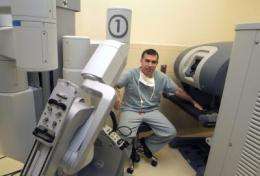Robots preclude neck incision for thyroid surgery

Robots that revolutionized gynecologic and urologic surgery in the past decade now offer the option of removing at least a portion of their diseased thyroid gland without the hallmark neck incision, researchers said.
The thyroid, which sits just under the Adam's apple and controls the body's metabolic rate, is about the size of a kiwi. Benign and cancerous disease can more than double its size. Dr. David Terris, Porubsky professor and chairman of the Medical College of Georgia Department of Otolaryngology-Head and Neck Surgery, has helped shepherd in minimally-invasive approaches that reduced neck incisions from several inches to less than an inch within the last few years.
The daVinci Surgical System, in which surgeons sitting at a console maneuver through tight spaces and around corners, enables access to the thyroid through the armpit, Terris said.
"In my opinion, if you are committed to not having a neck scar, this is the best way to do it," Terris said of patients who are trim, have benign disease and need only half of their two-lobed thyroid gland removed.
He and his colleagues - Dr. F. Christopher Holsinger, associate professor at the University of Texas MD Anderson Cancer Center, and Dr. Ronald B. Kuppersmith, clinical faculty member at Texas A & M Health Science Center - provide an overview of the robotic technique they are helping develop in the United States in the current print edition of Otolaryngologic Clinics of North America.
Although the armpit is farther from the gland than the neck is, simply raising the patient's arm during surgery shortens the path, leaving a fairly straightforward approach made navigable by the three- dimensional visualization and wrist-like maneuverability of the robot.
"The robot is what makes it possible to easily - and safely - do the work from that distance," Terris said. Surgeons gain access through a two-to-three-inch armpit incision, then work their way through skin and fat and finally in between two big neck muscles. "It's a long way down a big tunnel to get to that thyroid through the armpit that would not be possible without telescopes and long instruments," he said.
In the August 2004 edition of Laryngoscope Terris advocated the technique for select patients after comparing five minimally invasive approaches in pigs. While acknowledging that the armpit approach is a lot more work in humans, experience has enabled Terris to complete the procedure in less than two hours vs. under an hour via a three-quarter-inch neck incision.
Korean surgeons have the most experience to date with robotic thyroidectomy in humans and are using the approach to remove both lobes, Terris said, noting that cultural concerns about neck scars helped push Koreans to be pioneers in the field. He thinks improving technology will hasten the procedure's acceptance in the United States, where robotics in other medical procedures are already common.
In the journal article, the thyroid surgeons recommend that colleagues interested in the approach should complete robotics training, practice thyroid removal on cadavers, watch an experienced surgeon use the technique, then have a surgeon watch them.
















